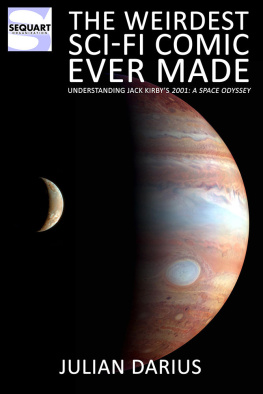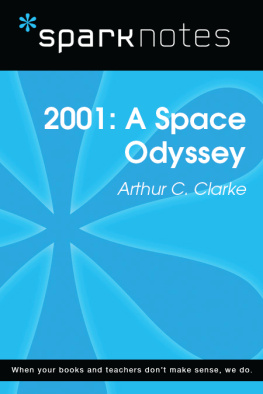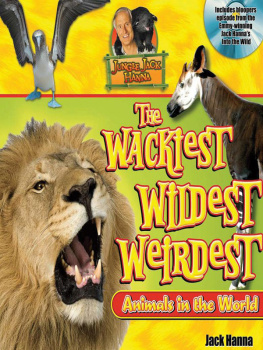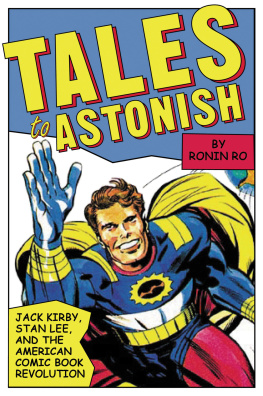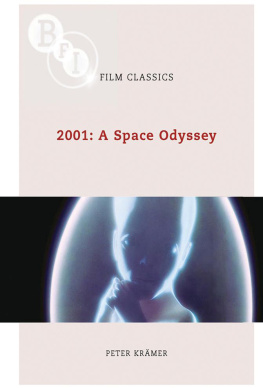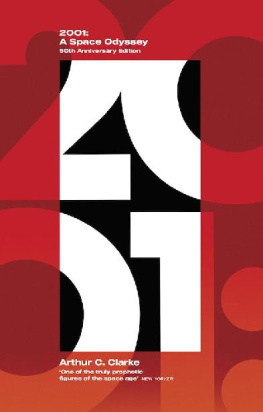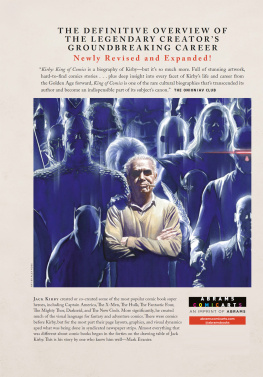Darius - The Weirdest Sci-Fi Comic Ever Made: Understanding Jack Kirbys 2001: A Space Odyssey
Here you can read online Darius - The Weirdest Sci-Fi Comic Ever Made: Understanding Jack Kirbys 2001: A Space Odyssey full text of the book (entire story) in english for free. Download pdf and epub, get meaning, cover and reviews about this ebook. year: 2013, publisher: Sequart Organization, genre: Science. Description of the work, (preface) as well as reviews are available. Best literature library LitArk.com created for fans of good reading and offers a wide selection of genres:
Romance novel
Science fiction
Adventure
Detective
Science
History
Home and family
Prose
Art
Politics
Computer
Non-fiction
Religion
Business
Children
Humor
Choose a favorite category and find really read worthwhile books. Enjoy immersion in the world of imagination, feel the emotions of the characters or learn something new for yourself, make an fascinating discovery.
The Weirdest Sci-Fi Comic Ever Made: Understanding Jack Kirbys 2001: A Space Odyssey: summary, description and annotation
We offer to read an annotation, description, summary or preface (depends on what the author of the book "The Weirdest Sci-Fi Comic Ever Made: Understanding Jack Kirbys 2001: A Space Odyssey" wrote himself). If you haven't found the necessary information about the book — write in the comments, we will try to find it.
Darius: author's other books
Who wrote The Weirdest Sci-Fi Comic Ever Made: Understanding Jack Kirbys 2001: A Space Odyssey? Find out the surname, the name of the author of the book and a list of all author's works by series.
The Weirdest Sci-Fi Comic Ever Made: Understanding Jack Kirbys 2001: A Space Odyssey — read online for free the complete book (whole text) full work
Below is the text of the book, divided by pages. System saving the place of the last page read, allows you to conveniently read the book "The Weirdest Sci-Fi Comic Ever Made: Understanding Jack Kirbys 2001: A Space Odyssey" online for free, without having to search again every time where you left off. Put a bookmark, and you can go to the page where you finished reading at any time.
Font size:
Interval:
Bookmark:
Understanding Jack Kirbys 2001: A Space Odyssey
Julian Darius

Sequart Organization (Edwardsville, Illinois)
Copyright 2013 by Julian Darius. Characters and works mentioned herein are trademarked by various owners.
Kindle edition, May 2013.
All rights reserved. Except for brief excerpts used for review or scholarly purposes, no part of this book may be reproduced in any manner whatsoever, including electronic, without express consent of the publisher.
The cover is a version of a NASA photograph of Jupiter and its moon Io. Book design by Julian Darius. Interior art is Marvel Comics; please visit www.marvel.com .
Published by Sequart Research & Literacy Organization. Edited by Mike Phillips. Thanks to Keith Howell, Markisan Naso, Richard Pachter, and Scott Puckett.
For information about other titles in this series, visit sequart.org/books .
Contents
Jack Kirbys 2001: A Space Odyssey is surely one of the strangest science-fiction franchise comics ever published.
For one thing, the comic appeared in 1976, eight years after the 1968 film debuted. In theory, the comic was timed to a re-release of the movie, which was a bigger deal in those days before home video. Still, most other sci-fi franchises (like Star Trek , Star Wars , and Battlestar Galactica ) saw comic books produced almost immediately with the franchises debut. Not only did the 2001 comic take almost a decade to appear, but there was no sequel film or novel, nor any other new material set in the Space Odyssey universe, during this intervening time. (The sequel novel, 2010 , wouldnt appear until 1982, and its film adaptation had to wait until 1984.)
And make no mistake the comic was an adaptation and continuation of the Stanley Kubrick film, not the Arthur C. Clarke novel that also appeared in 1968.
For another thing, the 1968 film has come to be regarded as almost sacred. Although it received mixed reviews upon its release (negative reviews pointing out the films plodding pace and lack of conflict during its first half), 2001 steadily increased in reputation and influence. Today, its often considered one of the finest films ever made and even more universally considered one of the finest sci-fi movies in history. Making it into a comic book can seem a little like adapting and continuing Citizen Kane .
This pattern of reception, from mixed reviews to greater praise over time, is typical of many films directed by Stanley Kubrick. Dr. Strangelove (1964), A Clockwork Orange (1971), The Shining (1980), and Full Metal Jacket (1987) are all regarded as classic films, although they divided critics upon release. Kubrick, perhaps more than any other American director, is regarded as an auteur a singular creative mind who dominates his work, even when its a collaboration (as all films are). Its hard to imagine a comic-book continuation of those other films. (Perhaps featuring the further adventures of the sociopathic Alex from Clockwork Orange , returning to ultra-violence and the old in-out?)
The very idea feels like sacrilege, less because of the low status afforded comics (one hopes) and more because any such continuation, by other creative minds in any medium, seems to dilute the special nature of the original. Its equally hard to imagine a cartoon series based on Full Metal Jacket (and if you dont believe this could happen, based on the violent content of that film, both Rambo and RoboCop got cartoons).
In 1976, however, Kubricks 2001: A Space Odyssey hadnt yet become such a sacred text. It was well-regarded enough that adapting it into one of Marvels oversized treasury editions might have made sense to someone at the company. After all, there were no home videos at the time, and adaptations served the very real purpose of giving readers some version of a movie that they could enjoy at home. With the films many grand visuals, it must have seemed like it was a perfect match for the treasury format even if the film had come out almost a decade earlier. Having adapted the film, an ongoing series might have seemed to make sense to Marvel. After all, such a beautiful treasury adaptation could serve as a high-profile springboard for such a series.
Even so, its worth noting that Star Wars which sent Hollywood scrambling to approve sci-fi films wouldn't come out until the following year (1977). Marvel had great success adapting and continuing that film. But in 1976, there was no history of success to point to, when making the choice to adapt and continue 2001 -- a film from eight years prior.
But the strangest thing about Kirbys 2001 is that Jack Kirby was the one to do it.
Kubricks 2001 is characterized by its long takes, its meditative quality, and its almost total lack of action. Its certainly a visually stunning film perhaps thats even its strongest element. But these visuals are elegant, beautiful, and characterized by their geometric precision and, indeed, their minimalism. Everything is understated. Even when whats being depicted concerns the fate of humanity, the dialogue is banal when theres dialogue at all. The musics often more important than any words, and theres certainly no punches and photon torpedoes, nor anything of the sort.
Its hard to overstate just how ill-suited Jack Kirby was to such material.
Like the film, Kirbys visual style is distinctive, but it couldnt be more different in tone. Kirby is bombastic. His art is famous for its extreme foreshortening, adding a sense of drama and excitement to leaps and punches. Hes action-oriented and in-your-face, whereas Kubricks film was all about the subtle. No one ever accused Kirby of being subtle. Indeed, his almost complete lack of subtlety is part of his charm. Its just not a charm which one could possibly imagine fitting 2001 .
The famous visuals in 2001 are stark. Minimal. Kirbys art is anything but. Indeed, while he was certainly a master of the comics form and profoundly influential, his art is often rather ugly. He excelled at wild, jagged technological devices, brimming with otherworldly energy, but his figures are all muscles, and his faces are almost uniformly brutish. His characters yes, even the women often look like mashed-up street brawlers, even when theyre supposed to be royalty, or are supposed to be defined by their gracefulness. Theres certainly an elegance to Kirbys wild illustrations, but theyre not exactly elegant .
Many of the long shots in 2001 are about establishing a sense of place whether its feeling the ship overwhelmed by the black vastness of space, or being able to visualize how humans would interact with the ships circular interior. Even as the ships computer, HAL, is deactivated, one gets a sense of the size of the room and how one navigates it in zero gravity. Its because of a portholes position that HAL is able to read the astronauts lips and figure out their plan. These are real settings, not sci-fi backdrops.
Kirby, in contrast, almost never communicates place in this way. He would toss torches or technological devices into a scene, but their function is to communicate ambiance, not to let the reader imagine characters interacting with a real, three-dimensional space. Hes simply not concerned with such matters, nor does he seem to see such precise settings as an integral part of the story itself. Even on this fairly subtle level, Kirby and Kubrick were very different brains.
Then theres Kirbys prose, which is often wildly overwritten a pattern he learned from earlier periods in comics history, when captions could describe what was shown visually, and from his collaboration with Stan Lee specifically. This doesn't fit well with the films long dialogue-free sequences. Kirbys prose is also spectacularly purple more poetic than Lees and at times quite effective, but purple nonetheless. Again, not a great fit with Kubrick. Especially when, in the comic, Kirby would use captions and thought balloons to spell out, in melodramatic language, what the film leaves implicit or ambiguous.
Font size:
Interval:
Bookmark:
Similar books «The Weirdest Sci-Fi Comic Ever Made: Understanding Jack Kirbys 2001: A Space Odyssey»
Look at similar books to The Weirdest Sci-Fi Comic Ever Made: Understanding Jack Kirbys 2001: A Space Odyssey. We have selected literature similar in name and meaning in the hope of providing readers with more options to find new, interesting, not yet read works.
Discussion, reviews of the book The Weirdest Sci-Fi Comic Ever Made: Understanding Jack Kirbys 2001: A Space Odyssey and just readers' own opinions. Leave your comments, write what you think about the work, its meaning or the main characters. Specify what exactly you liked and what you didn't like, and why you think so.

